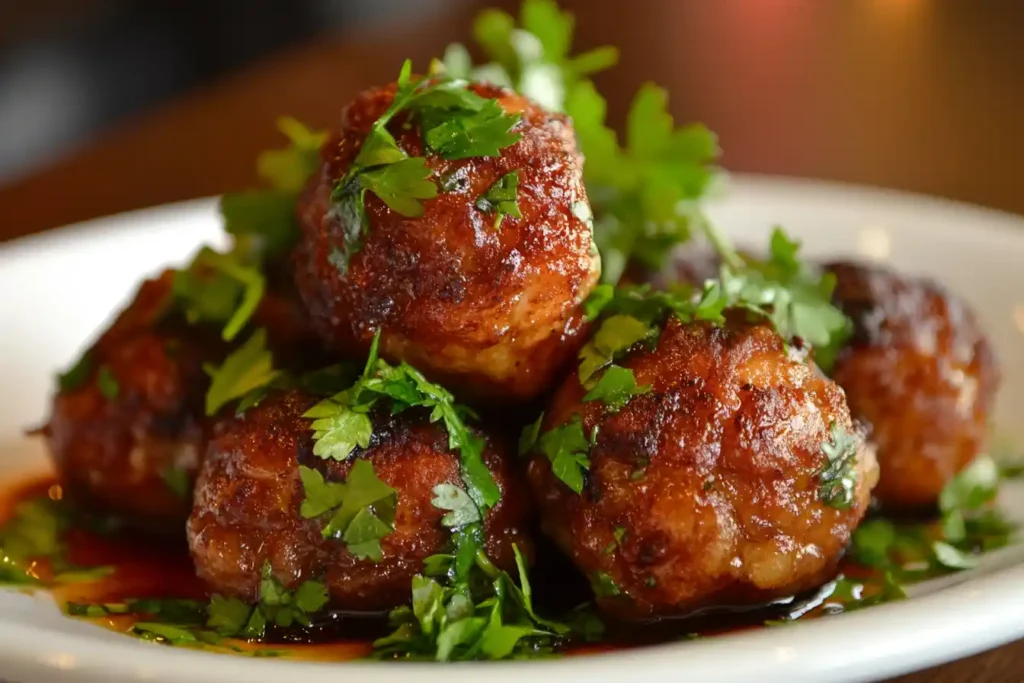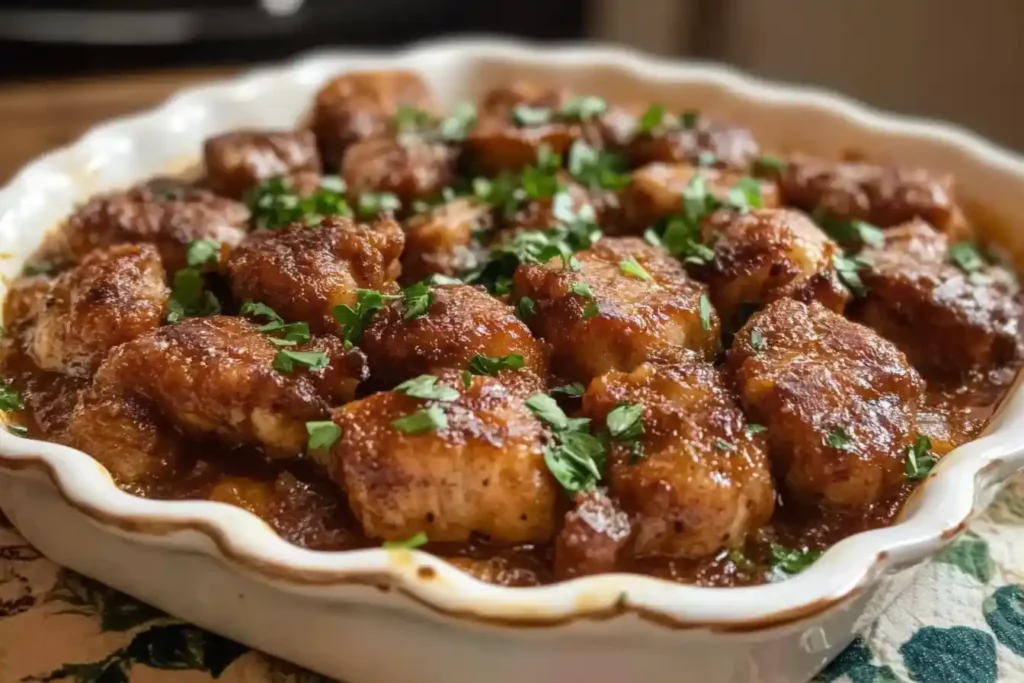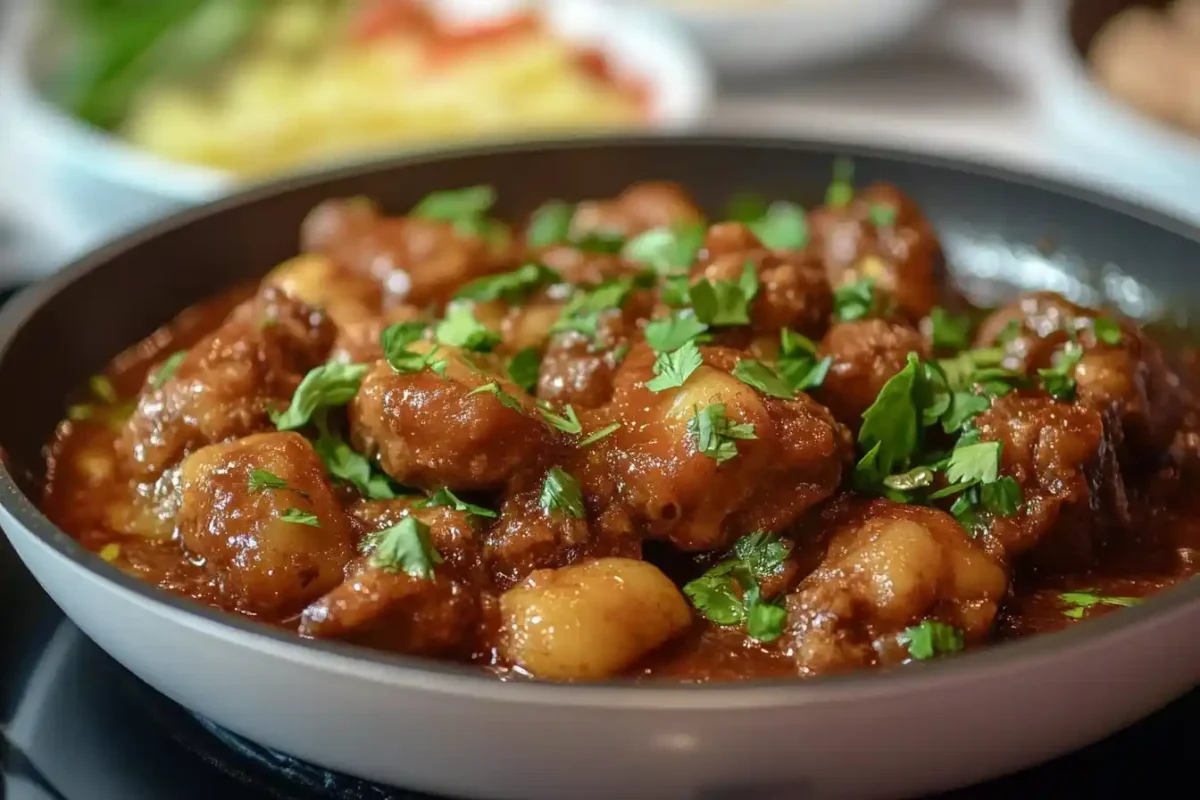Learn how to select, prepare, and cook beef sweetbreads—also known as veal sweetbreads or calf thymus. Explore their mild flavor, soft texture, and find out how to serve these offal cuts with ease.
Introduction to Beef Sweetbreads (Veal Sweetbreads, Calf Thymus, Offal Cuts)
Beef sweetbreads, often from a cow’s thymus or pancreas, are offal cuts that U.S. home cooks rarely use. Meanwhile, they are known for their creamy, mild taste and soft, tender bite. If you’re wondering what sweetbreads are in the UK, they often refer to similar cuts, but the term may vary in usage depending on the region. Additionally, veal sweetbreads (from younger cattle) often appear in gourmet dishes, so learning to cook them at home can be impressive. Therefore, by mastering a few steps, you can enjoy something truly different.
Admittedly, many feel unsure about cooking beef sweetbreads, but they are worth exploring. Furthermore, serving them can impress your family and guests. Consequently, when you learn a few simple techniques, you can turn these unusual parts into memorable meals. Thus, it is time to move beyond standard cuts and try something new.
For instance, for more information on cooking offal, visit the James Beard Foundation’s pages. Similarly, the Serious Eats offal section can guide you. Moreover, the Smithsonian culinary pages might help you understand their historical value.
Altogether, beef sweetbreads open up new tastes and textures. In fact, rather than sticking to steaks or roasts, you can enjoy a mild, creamy flavor. In the next installment, we will look at the background and see why people in many places value them so highly.
Historical and Cultural Background of Beef Sweetbreads (Veal Sweetbreads, Calf Thymus)
Early Use of Offal Cuts
Initially, people used every part of the animal to avoid waste. Accordingly, offal cuts like beef sweetbreads were once common. Eventually, many cultures prized them for flavor and nutrients. Comparatively, they were not odd, but rather a normal part of meals long ago.
European Culinary Traditions
Notably, in Europe, veal sweetbreads took on a gourmet role. Firstly, French chefs included them in rich, creamy dishes. Likewise, Italian and Spanish cooks simmered them in gentle broths. Consequently, these practices lifted sweetbreads from simple fare to fine dining, proving that careful cooking can transform unusual parts.
Modern Shifts in the U.S.
In recent years, the U.S. culinary scene has changed. Gradually, diners now seek new experiences, and beef sweetbreads offer just that. As a result, more chefs and home cooks give them a chance. Hence, these mild glands, once overlooked, now gain attention in upscale kitchens.
In the subsequent chapter, let’s consider their nutrients. Surely, understanding their nutrition can help you decide how often to include them.
Nutritional Profile and Health Considerations (Veal Beef Sweetbreads, Offal Cuts)
Key Nutrients and Benefits
Undoubtedly, beef sweetbreads provide protein, B vitamins, and minerals. Likewise, these offal cuts often have more natural nutrients than many processed meats. Therefore, enjoying them occasionally can add variety to your diet. Altogether, they offer a good source of essential elements in small servings.
Balancing Dietary Choices
However, they do contain cholesterol, so eat them in moderation. Certainly, you might treat them as a special dish rather than everyday fare. If possible, speak with a health expert if you have concerns. Overall, balance and portion control ensure you enjoy them without worry.
Moderation and Portion Control
Moreover, serve small portions to keep the meal balanced. Instead of making them the main focus, pair them with other foods. This way, you savor their flavor without going overboard.
In the following segment, let’s explore their taste and texture, which set them apart from other meats.
Taste and Texture Characteristics (Veal Beef Sweetbreads, Calf Thymus)
Mild, Gentle Flavor
Although they belong to offal, beef sweetbreads are mild. Indeed, they do not have the strong taste some organ meats carry. Instead, they present a gentle creaminess that can please even first-time tasters. Thus, veal sweetbreads and calf thymus can surprise many with their easy-to-like flavor.
Soft, Tender Texture
Equally, their texture is smooth and velvety. When prepared properly, they become almost silky inside. Because of this, every bite feels delicate and pleasant. Consequently, people who try them often enjoy their unique mouthfeel.
How Cooking Methods Affect Flavor and Texture Beef Sweetbreads
Clearly, cooking methods matter.
- Sautéing: Adds a light crust while keeping them soft.
- Grilling: Gives a gentle smoky note without ruining their tenderness.
- Poaching or Sous Vide: Keeps them moist and silky.
- Frying: Creates a crisp outside that contrasts with the creamy inside.
In the next division, we will discuss how to find quality sweetbreads and what to look for before buying.

Sourcing and Selecting Quality (Veal Beef Sweetbreads, Offal Cuts)
Where to Find Good Beef Sweetbreads
Usually, grocery stores may not carry them regularly. Therefore, check local butcher shops, specialty meat markets, or farmers’ markets. Alternatively, consider online suppliers who specialize in offal cuts. By doing so, you ensure you get fresh, well-handled sweetbreads.
Checking for Freshness
Obviously, freshness is key. Hence, choose sweetbreads that look pale and firm with no bad smell. If unsure, ask the butcher for advice. Most importantly, trust your senses and buy from a reputable source.
Calf vs. Mature
Comparatively, veal sweetbreads, from younger cattle, often taste milder. Conversely, older beef sweetbreads may be slightly firmer. Regardless, both can taste great. Simply, pick what you prefer or what is available.
Transitioning into the subsequent portion, let’s learn how to prepare them so they taste their best.
Prepping and Cleaning (Veal Beef Sweetbreads, Calf Thymus)
Initial Soaking
Before cooking, soak beef sweetbreads in cold water for several hours. Likewise, change the water a few times. As a result, you remove blood and any strong odors, leaving them mild and clean.
Removing Membranes and Trimming
After soaking, briefly blanch them, then shock in ice water. Afterwards, peel away membranes and tough bits. By doing this, you achieve a smooth, tender result. Otherwise, leaving membranes can cause chewy, unpleasant bites.
Common Prep Mistakes
- Overlooking the Soak: Without soaking, flavors remain stronger.
- Not Removing Membranes: Tough parts remain, ruining texture.
- Handling Roughly: They are delicate, so treat them gently.
In the next phase, we explore cooking methods that bring out their best features.
Cooking Techniques and Methods for (Veal Beef Sweetbreads, Offal Cuts)
Blanching for Better Texture
Firstly, blanching sets their shape and removes impurities. Then, further cooking steps become easier, ensuring better results.
Poaching for Subtle Taste
Secondly, poaching keeps them moist and gentle in flavor. Additionally, you can add mild herbs or aromatics to the poaching liquid. Thus, they pick up pleasant notes without overwhelming their natural taste.
Sautéing for a Light Crust
Thirdly, sautéing in butter or oil gives them a slight golden crust. Consequently, this adds texture and a hint of richness. Thus, a quick sauté can elevate their simple flavor profile.
Grilling for a Hint of Smoke
Fourthly, grilling lends a mild smoky note. Moreover, as long as you keep the heat moderate, they stay tender inside. Hence, grilling provides a welcome contrast of flavors.
Frying for Crunchy Texture
Fifthly, frying with a light coating of flour or crumbs results in a crisp shell. Notably, this crunch contrasts nicely with their creamy center. In fact, a fried version can appeal to those who enjoy textures.
Sous Vide for Exact Doneness
Lastly, sous vide cooking ensures perfect temperature control. Indeed, you get even doneness and consistent tenderness. Eventually, a quick sear before serving adds color and flavor.
Advancing to the next topic, let’s look at traditional and global recipes that celebrate these cuts.
Traditional and Global Dishes Featuring (Veal Beef Sweetbreads, Calf Thymus)
French Classics
In French cuisine, veal sweetbreads often appear with creamy sauces and mushrooms. Not surprisingly, these dishes show off French skill at making delicate foods shine. Therefore, many see them as a symbol of refined cooking.
Italian Preparations
In Italy, cooks simmer calf thymus in white wine and mild herbs. Hence, the sweetbreads remain subtle, not overpowered. Combined with pasta or polenta, they create a comforting meal without heavy flavors.
South American Grills (Mollejas)
In South America, grilled mollejas (sweetbreads) are common at barbecues. Occasionally, they use just salt and gentle heat, allowing the creamy texture to star. As a result, this simple method highlights their natural goodness.
Modern Fusion Approaches
Nowadays, chefs worldwide experiment with sweetbreads by mixing global flavors. For example, they might pair them with Asian sauces or present them as small bites in tasting menus. Clearly, their flexibility makes them welcome in many cuisines.
Continuing in the following part, we will discuss flavor pairings and the ingredients that work best with sweetbreads.
Flavor Pairings and Complementary Ingredients (Veal Beef Sweetbreads, Offal Cuts)
Herbs and Mild Spices
Basically, mild herbs like thyme, sage, or chives suit their gentle taste. Additionally, a bit of lemon zest can brighten them. Instead of strong spices, choose light seasonings that support their natural flavor.
Light Sauces and Reductions
Moreover, simple wine or butter sauces can lift their taste. Instead, avoid heavy sauces that hide their flavor. Therefore, gentle reductions, mild stock, and subtle herbs all work well.
Vegetables and Grains
Equally, roasted vegetables, fresh greens, or creamy polenta add contrast. Similarly, grains like barley or rice can offer texture and balance. Consequently, these sides make the meal more complete.
Wine and Beverage Pairings
In terms of drinks, dry white wines or light reds often match their flavor. Occasionally, sparkling wine can also work. For non-alcoholic options, sparkling water with citrus or mild teas complement them. Hence, pick drinks that do not overpower.
On to the following discussion, let’s follow a simple recipe that shows you how to cook sweetbreads at home.

Signature Beef Sweetbreads Recipe (Step-by-Step)
Ingredients Beef Sweetbreads
- 1 lb beef sweetbreads (or veal sweetbreads, soaked and trimmed)
- 4 cups cold water (for soaking)
- 2 tablespoons butter
- 1 tablespoon olive oil
- 2 cloves garlic, minced
- 1 tablespoon fresh thyme leaves
- Salt and pepper to taste
- ½ cup dry white wine
- 1 cup low-sodium beef broth
- 1 tablespoon fresh lemon juice
Instructions
- Soak the Sweetbreads:
First, place them in cold water in the fridge for 2-4 hours, changing the water a couple of times. As a result, you get cleaner flavor. - Blanch and Cool:
Then, simmer them in lightly salted water for about 5 minutes. Afterwards, plunge into ice water. Accordingly, this stops cooking and firms them up. - Trim and Portion:
Next, peel away membranes and cut into even pieces. Subsequently, season lightly with salt and pepper. - Sauté Aromatics:
Meanwhile, warm butter and oil in a pan. Afterward, add garlic and thyme, stirring until fragrant. Hence, you build a gentle flavor base. - Cook the Sweetbreads:
Now, add the pieces and sauté until lightly golden. Eventually, work in batches if needed. Notably, avoid high heat that might burn them. - Deglaze the Pan:
Then, pour in white wine, scraping the pan bottom. Consequently, flavors mix into a subtle sauce. - Add Broth and Finish:
After that, add beef broth and let it thicken slightly. Finally, stir in lemon juice and adjust seasoning. Thereupon, you achieve a balanced, mild sauce. - Serve:
At last, plate the sweetbreads and spoon the sauce over them. Certainly, garnish with thyme for a final touch.
Heading into the subsequent area, let’s see how best to present and serve this dish.
Presentation and Serving Beef Sweetbreads
Plating Tips
To enhance presentation, serve them on warm plates. Ideally, place them on creamy polenta or mashed potatoes for a soft base. Likewise, add a few bright greens for color. Altogether, simple plating can make them look inviting.
Simple but Elegant Garnishes
For garnish, try fresh thyme leaves or a twist of lemon. Additionally, a light drizzle of olive oil can add shine. Thus, keep it simple yet attractive.
Serving as Appetizers or Mains
Depending on portion size, small amounts work as appetizers. Conversely, larger servings make a satisfying main course. In either case, pair with vegetables or grains for balance. Thus, you can adapt the dish to any meal plan.
In the next subsection, we discuss how to store and reheat leftovers without losing quality.
Storing and Reheating Leftovers
Proper Storage
After the meal, place leftovers in an airtight container in the fridge. Preferably, eat them within a day or two. Otherwise, they might lose flavor or texture.
Reheating Methods
When ready to reheat, use low heat in a pan with butter or broth. Therefore, you avoid drying them out. Instead of microwaving, choose gentle stovetop warming for best results.
Creative Uses for Leftovers
If you want variety, add sliced leftover sweetbreads to salads, sandwiches, or pasta. This way, their mild flavor complements many dishes. Eventually, you discover new ways to enjoy them.
In the next phase, let’s highlight common mistakes and how to avoid them.
Common Mistakes to Avoid When Cooking Beef Sweetbreads
- Overcooking:
If overcooked, they become tough. Thus, watch the time and heat. - Skipping the Soak and Blanch:
Without these steps, strong flavors remain. Hence, always soak and blanch. - Overpowering Seasonings:
If you add too many spices, you mask their gentle flavor. Instead, keep it mild. - No Resting Time:
By not letting them rest, you lose juiciness. So, rest them briefly before serving.
In the ensuing segment, we will answer common questions about these special cuts.
Frequently Asked Questions (FAQ) About Beef Sweetbreads
What is beef sweetbread meat?
Simply put, it is the thymus or sometimes pancreas gland of a cow. Thus, these offal cuts are known for their mild, creamy taste and tender texture.
What part of the cow is Sweetbreads?
Typically, sweetbreads come from the thymus gland of young cattle. Occasionally, the pancreas also counts as a sweetbread. Therefore, both come from glands, not muscle.
Why are they called sweetbreads?
Historically, “sweet” meant pleasing and “bread” could mean flesh. Thus, the name suggests mild, pleasant meat rather than sweetness.
Are sweetbreads balls?
No, they are not testicles. Instead, they are glands. Hence, do not confuse sweetbreads with testicles, known as “rocky mountain oysters.”
On to the following discussion, let’s wrap up our findings and encourage you to try them in your own kitchen.
Conclusion and Final Thoughts Beef Sweetbreads
In summary, beef sweetbreads can bring a new element to your cooking. Although they seem unusual, their mild flavor and smooth texture reward gentle preparation. By learning simple steps, you can serve dishes that amaze guests and expand your culinary range.
Moreover, their softness and subtle taste let you explore new flavors beyond standard cuts. Hence, do not fear veal sweetbreads or calf thymus. By embracing them, you honor long food traditions and open your menu to unique bites.
In the next division, take these insights into your kitchen. Surely, with practice and care, you can create memorable meals featuring these delicate offal cuts.

